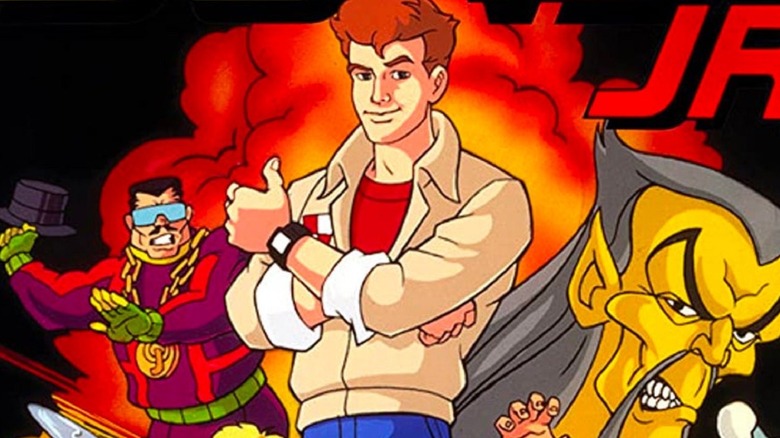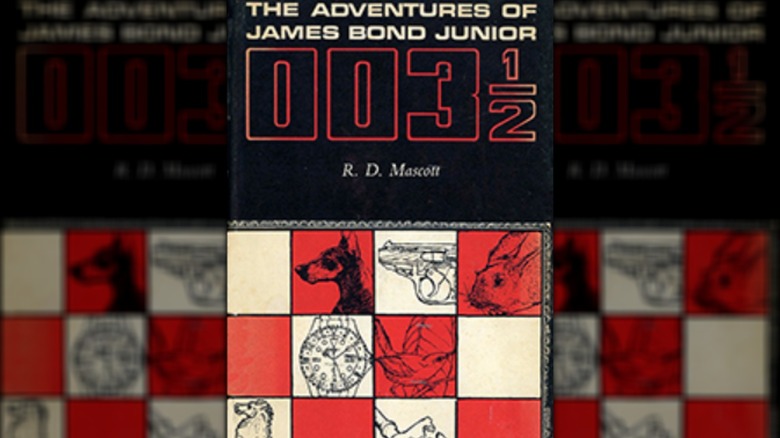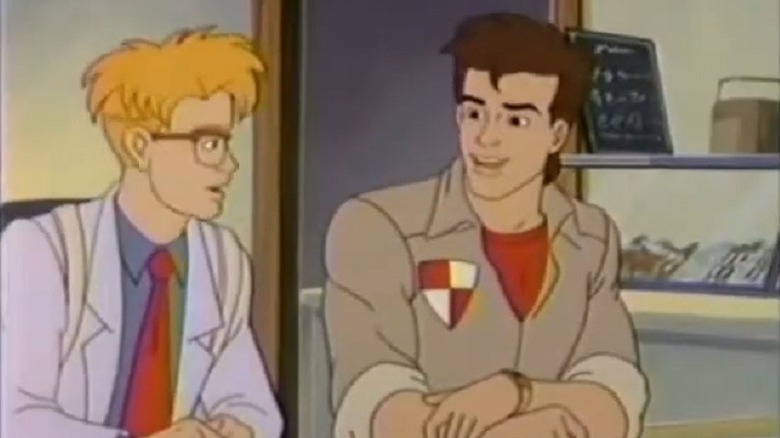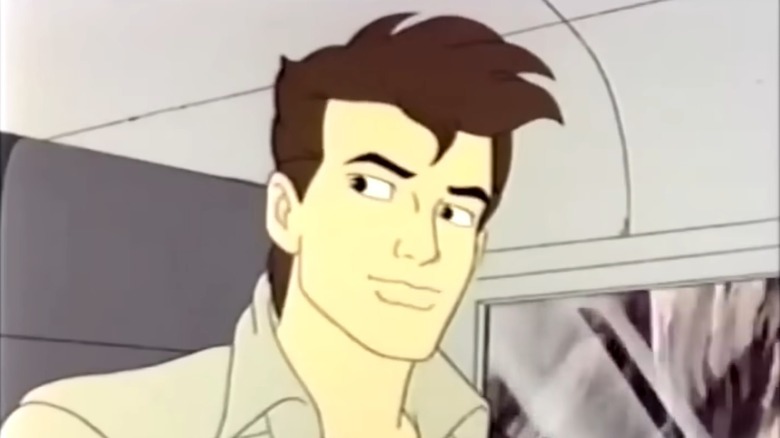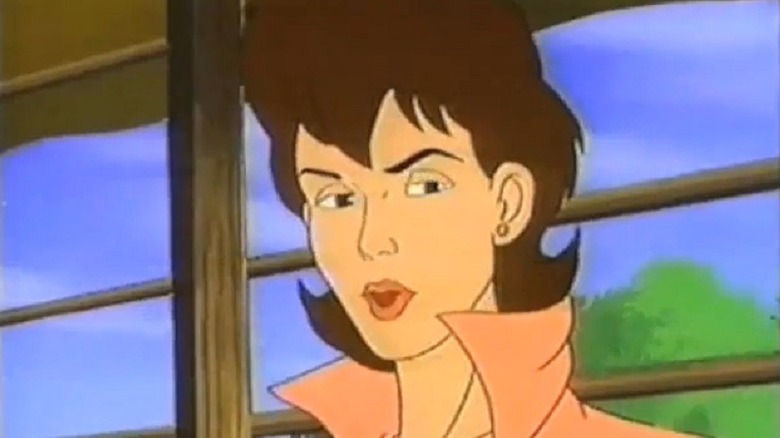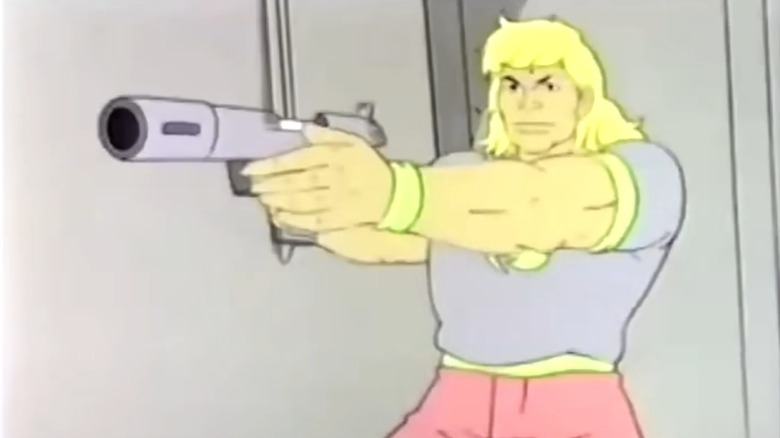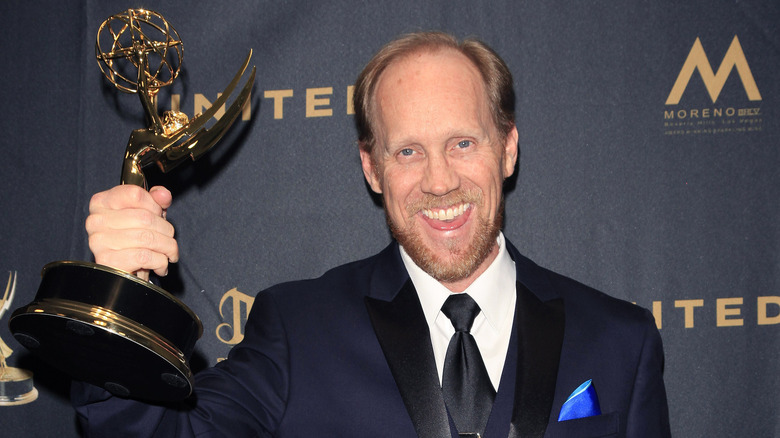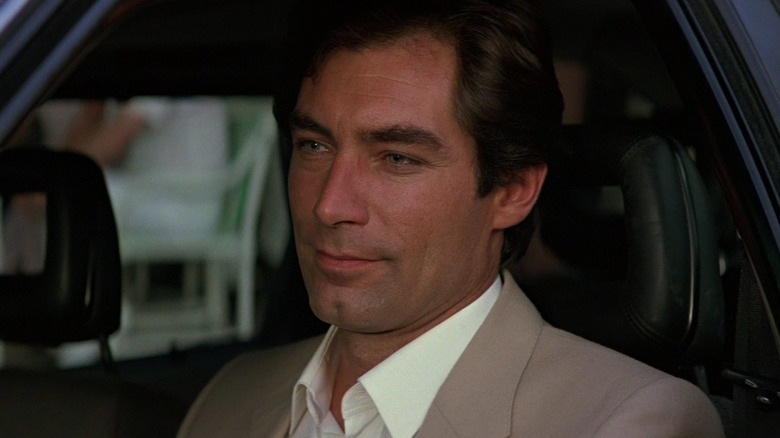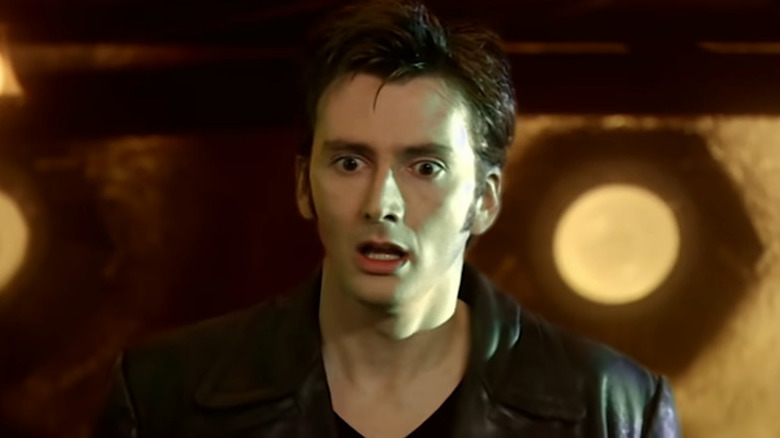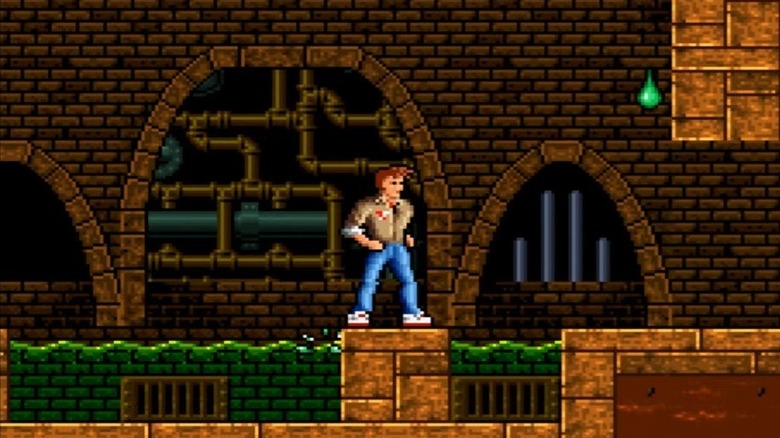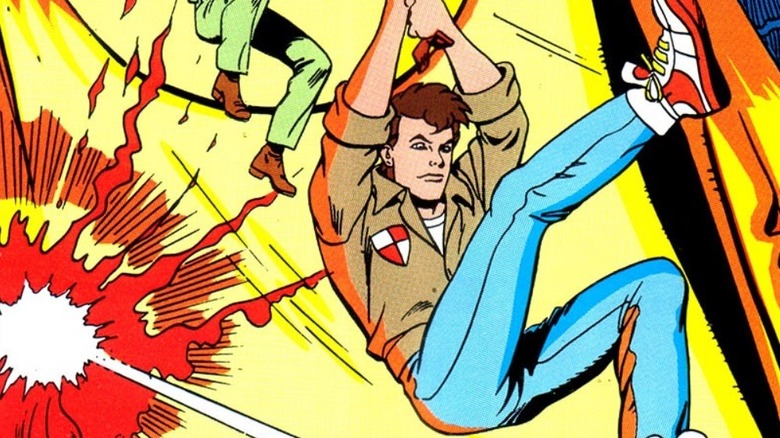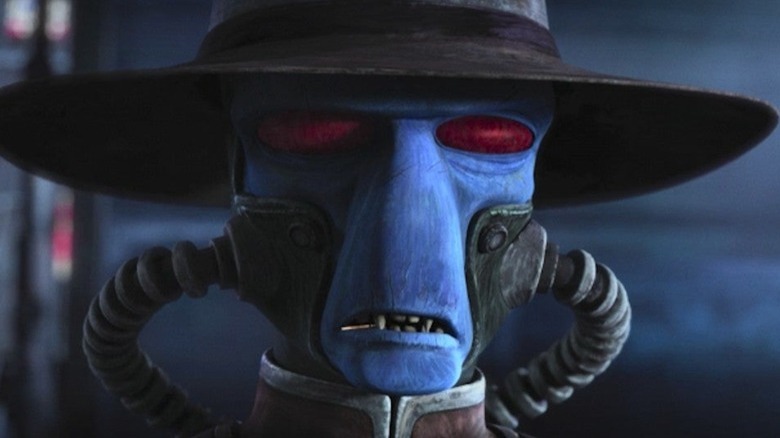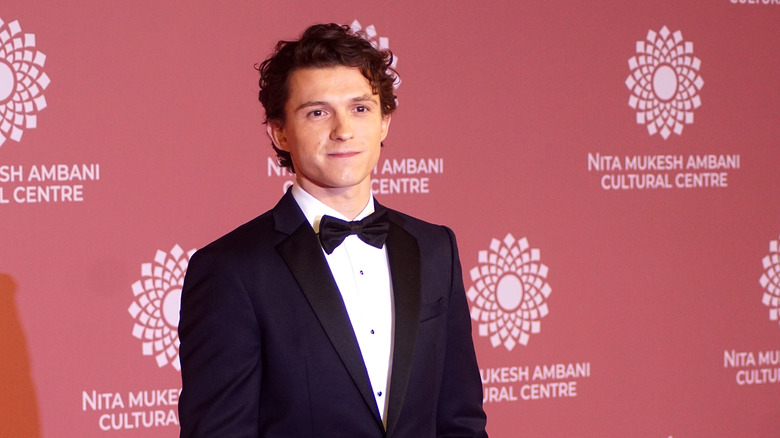The Untold Truth Of The Long-Forgotten James Bond Jr. Cartoon
"The name's Bond ... James Bond Jr." Wait, what? As the theme song to this long-forgotten animated series told us, he is James Bond's younger nephew. Although it would make more sense for 007 to be his father, this cartoon seems to suggest that every male member of the Bond family is named James.
Regardless of the confusing family tree dynamics, "James Bond Jr." unsurprisingly takes its main beats from the 007 film series, with Junior facing off against familiar villains like Jaws, Goldfinger, Oddjob, and Dr. No. Every episode features the young Bond and his pals stopping a nefarious scheme orchestrated by the criminal organization known as Saboteurs and Criminals United in Mayhem (S.C.U.M) — led by the mysterious Scumlord, whom most fans presume to be Ernst Stavro Blofeld. Released in 1991, the show aired for 65 episodes and received a wide array of merchandise, including a toy line series that boasted Bond's kitted-out and weaponized red sports car.
Despite the international release and notable merch push, the animated series is largely a lost relic of the franchise – a lot like "The Young Indiana Jones Chronicles" in the sense that only diehard fans remember it. With that said, let's shake and stir to uncover the untold truth of "James Bond Jr."
James Bond Jr. debuted in a novel first
It isn't unusual for storytellers to create younger versions of popular characters. After all, the Superboy concept began as a way to focus on the adventures of a younger, less established Clark Kent. This is often done to appeal to younger audiences, as it makes the heroes more age relatable than the adult versions. Similarly, the origin of "James Bond Jr." is rooted in appealing to children and teens, however, this happened all the way back in 1967.
Written under the pseudonym of R. D. Mascott, "The Adventures of James Bond Junior: 003½" was the world's first introduction to Junior. In this tale, he is the son of James Bond's brother, David. Still in school, Junior uncovers the mystery of bank robberies in his town and even communicates with his famous uncle via snail mail. Since he is 007's nephew — and everyone seems to know this since secret spy means nothing here — he is dubbed 003½.
The true identity of the author still remains uncertain, though many dedicated fans and historians believe it to be British author Arthur Calder-Marshall. At one point, there was a suspicion that "Charlie and the Chocolate Factory" author Roald Dahl could have been writing under the pseudonym of R. D. Mascott, but this is a lot less likely.
James Bond Jr. came about because of a lawsuit
In 1988, Kevin McClory — who owned specific rights to the James Bond franchise — decided he wanted to take 007 to the world of television. Speaking to Variety (via Cartoon Research), he announced plans to produce an animated series titled "James Bond vs. S.P.E.C.T.R.E," which is fairly self-explanatory in what it would have featured.
There was another problem brewing, though: The franchise was about to be contested in a lengthy lawsuit between producer Albert R. Broccoli's Danjaq company and studio MGM. Upon hearing about McClory's plan, Michael G. Wilson and Barbara Broccoli who represented Eon Productions — a division of Danjaq — started to negotiate with production companies to create their own Bond animated show. This was in an effort to keep the franchise alive during the legal battle and to minimize anything McClory planned to do.
Eon set the ground rules from the start and made sure the show could not be about a young 007, but his nephew instead. The production company wanted to make a merchandising machine that would keep the brand name ticking over while not compromising on any future plans. In the end, "James Bond Jr." was produced, while McClory's "James Bond vs. S.P.E.C.T.R.E" never became a reality.
The original concept had James Bond Jr. trying to find his parents
What is it with heroes and the lack of parents? From Spider-Man to Batman, it appears as if these individuals only find their purpose in life when something happens to their parents. Seemingly, the original premise for "James Bond Jr." would have featured young James searching for his kidnapped parents, as confirmed by "The Lost Adventures of James Bond" author Mark Edlitz while appearing on "James Bond Radio."
In the end, this wasn't the direction taken for the show. Instead, the teenage James is sent to Warfield Academy where he and his new friends, such as IQ, Gordo, Phoebe, and Tracy, have to stop S.C.U.M. while also navigating high school life and their nosey, troublemaking colleague Trevor Noseworthy IV. James' parents never really feature as characters in the story since he is in boarding school.
In retrospect, it was likely a wise decision, since a focus on James' parents would have raised more questions about the history of 007. After all, in the Ian Fleming novels, it is said that 007 is an orphan with no brothers or sisters. The only possible explanation to maintain that canon would be that one or both of Bond's parents had secret dalliances with other people, and this might have been a little too adult to cover in a children's program.
One character was a nod to James Bond's first wife
James Bond is the ultimate playboy. Despite the death-defying missions and pressures of being an MI6 agent, he still finds the time to jet around the world and woo a plethora of women. Yet, Bond settles down when he meets Teresa "Tracy" Draco. He marries her in "On Her Majesty's Secret Service" and is left devastated after her death, with many fans viewing her as Bond's one true love.
As per CrimeReads, the character Tracy Milbanks in "James Bond Jr." is something of a tip of the hat to Bond's deceased wife. While Ms. Milbanks and the late Mrs. Bond have slightly different backstories and personalities, they are both utilized as love interests in their respective narratives.
While Tracy and Junior never start a full-blown romance in the series — remember, this is a '90s cartoon, and parent groups would riot — it's clear there is a mutual interest in each other. Ultimately, Tracy becomes a part of James' friendship circle and ends up entangled in his missions — even though she is the headmaster's daughter and could blow the lid on everything taking place. Despite the presence of Tracy, this doesn't stop James from encountering other "Bond girls" and flirting with them throughout the show.
There were no deaths in the episodes
The "James Bond" films aren't shy of violence. Unlike a few heroes who have strong morals and qualms about killing, 007 isn't afraid to grab his gun and dispatch a bad guy when the need calls for it. In fact, he isn't averse to blowing up things either, and he leaves a trail of destruction for the bureaucrats at the MI6 headquarters to deal with afterward.
The intro for "James Bond Jr." showcases explosions, rockets, and guns, indicating that there could be a few casualties on the show. Of course, like other cartoons of the era, it was always unlikely that there would be flying body parts or blood gushing on screen. Yet, despite this, there is no indication that anyone dies here, at least not from the violent acts, as per Entertainment Weekly.
Folks fall from ridiculous heights and even have nukes dropping around them, but all they need to do is dust themselves off and carry on villaining. Considering the young James is still a teenager here, and the target demographic of the show, this perhaps isn't too surprising.
The show was one of Jeff Bennett's first voice acting jobs
The name Jeff Bennett is well known in the voice acting world, and he has starred in countless productions across film, television, and video games. His most notable roles include Brooklyn in "Gargoyles," Johnny Bravo in the titular show, and Dexter's Dad in "Dexter's Laboratory." Bennett's career culminated with him receiving a Daytime Emmy Award for his work on "Transformers: Rescue Bots" in 2016.
Like all voice actors, though, Bennett had to start somewhere and he had his beginnings in the radio industry before receiving his big break. "I enjoyed doing the radio spots, and when I came out here, I hooked up with people who were looking for new blood," Bennett told Wired. "I was just getting ready to do a workshop with Sue Blue, and then she cast me with Corey [Burton] on 'James Bond Jr.' I played IQ, the grandson of Q. That was one of my first jobs."
Bennett displayed his versatility as he voiced several other characters on the show as well, bringing the villains Scumlord, Nick Nack, and Oddjob to life on the small screen.
The older 007 was supposed to appear
Before "James Bond Jr." debuted in 1991, the last time Uncle James had been seen by the audience was in 1989's "License to Kill," starring Timothy Dalton as 007. For all intents and purposes, the animated series was never positioned to feature the older Bond at all. His presence was still felt in the show, though, as the young James mentioned him quite often and other characters spoke freely of their association to him. However, Bond was presumably swimming with sharks or stopping a nuclear warhead, and couldn't find the time to drop by and spend a day with his nephew at Warfield Academy.
According to "The Lost Adventures of James Bond" author Mark Edlitz, that wasn't always the plan. "An early idea was that James Bond would occasionally show up on the scene," Edlitz told "James Bond Radio." As Edlitz added, this would have necessitated the need for an actor to portray 007 in this adaptation. Considering how animated series operated in that era and the lawsuit that took place, it was highly unlikely Dalton would have reprised his role here. After all, neither Sylvester Stallone nor Peter Weller reprised their roles in the "Rambo: The Force of Freedom" and "RoboCop" animated series respectively.
James Bond Jr.'s connection to Doctor Who
Much like other animated series of the time, "James Bond Jr." expanded far beyond its show. Apart from the toys and video games, episodes from the program were turned into six novelizations published by Penguin Books. Of course, these books had the most James Bond-esque titles such as "Live and Let's Dance" and "A View to a Thrill."
The author of these books went by the name of John Vincent, however, this was a pseudonym used by writer John Peel. "Doctor Who" fans will recognize this name, as Peel wrote a few comic strips and books based on the time-traveling doctor throughout the years.
As revealed by Peel on his website, it wasn't his choice to write the "James Bond Jr." novels under a pseudonym, but since he was a fan of 007, he was excited about the project — until he saw the scripts he would be adapting. "My editor selected the six least-worst scripts for me to work on, and there was a lot to be done to make them readable," Peel wrote. "I did my best, but the books and the show disappeared quickly."
The video game differs drastically across platforms
If a television program in the '90s didn't have a video game adaptation, did it even exist? Well, "James Bond Jr." didn't need to worry about that, as it hit the 8-bit and 16-bit formats in 1992. While Sega Genesis fans didn't receive any love and were left drying their eyes with the manuals of "Sonic the Hedgehog 2" and "Streets of Rage 2," Nintendo welcomed the young Bond to its two major platforms.
The premise of the game is as simple as it comes: James needs to use his gadgets to battle the evil agents of S.C.U.M. However, as MI6-HQ.com explains, the gameplay is quite different. While the storyline remains the same, the NES leans more toward being a platformer and including puzzle elements to rack the brain, while the SNES features vehicular combat and no puzzle-solving sections.
Of course, the SNES boasted far more power than its 8-bit sibling, allowing for better graphics and gameplay. Still, it's interesting to note the different approaches taken even if the plot is the same.
James Bond Jr. is technically part of the Marvel Universe
The television show, novels, and video game weren't enough. "James Bond Jr." wanted to take over the comic book industry, too, so it made the jump to the medium, thanks to Marvel Comics. There were other non-Marvel-created animated shows such as "Biker Mice from Mars" that received their own series at Marvel, but they didn't last nearly as long as "James Bond Jr." did.
Inspired by the adventures from the show, this comic book run lasted for 12 issues, which could easily translate into two volumes if the series was to be collected in a graphic novel format. Undoubtedly, the series was aided by the talent who worked on the book. Artist Mario Capaldi had drawn "Zorro" for Marvel in the past, while writer Dan Abnett went on to become an industry legend and produce significant work for the likes of Marvel, DC, and 2000 AD.
Corey Burton went on to become a big name in Star Wars cartoons
As the star of "James Bond Jr.," it was necessary to find the right voice for the titular character. The person selected for the role was American voice actor Corey Burton. By the time he boarded the project, he already had established himself in the industry, having provided the voice of the chipmunk Dale in "Chip 'n Dale: Rescue Rangers" and voicing a litany of bots in "The Transformers."
Yet, Burton's rise in the industry continued long after "James Bond Jr." had its license to air revoked. Some of his more notable roles included portraying Captain Hook in "Peter Pan" sequel "Return to Neverland" and Hugo Strange in the video game "Batman: Arkham City."
His most iconic performances, though, are in the "Star Wars" universe. He voiced Count Dooku in "Star Wars: The Clone Wars" and "Tales of the Jedi," while he has also played Cad Bane in "The Clone Wars," "Star Wars: The Bad Batch," and "The Book of Boba Fett."
There are no plans for a James Bond Jr. movie
After the fate of Daniel Craig's James Bond in "No Time to Die," many fans were left wondering what the next Bond movie would look like. Of course, a recasting would be necessary since Craig's time was up, but chatter started circulating that it could be a much younger 007 than fans expect. A few months later, an interview with "Spider-Man" actor Tom Holland surfaced where he mentioned he had pitched a young Bond origin story, but it had gone nowhere.
Suddenly, those who had watched the "James Bond Jr." cartoon had their interest piqued, wondering if a version of the story could make it to the screen. Perhaps the hero wouldn't be 007's nephew in the live-action film, but simply a younger version of the spy learning his craft.
All those hopes were crushed when producer Michael G. Wilson said there was no chance of a young 007 on screen. "We've tried looking at younger people in the past," he explained at a British Film Institute event (via Esquire). "But trying to visualize it doesn't work. Remember, Bond's already a veteran. He's had some experience. He's a person who has been through the wars, so to speak. He's probably been in the SAS or something."
